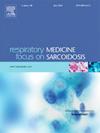周围气道功能障碍的振荡测量区分哮喘与诱导性喉梗阻。
IF 3.5
3区 医学
Q2 CARDIAC & CARDIOVASCULAR SYSTEMS
引用次数: 0
摘要
背景:诱导性喉梗阻(ILO,也称为声带功能障碍)在临床上很难与哮喘区分。有限的研究探索了使用呼吸振荡测量法来检测ILO特有的变化,但需要更多的研究来确定常规振荡测量法是否可以区分这两种临床实体。目的:确定常规振荡法测量的潮汐呼吸阻抗变量在哮喘患者和ILO患者之间是否存在差异。方法:在罗切斯特大学医学中心招募哮喘和ILO患者参加一项单中心观察性研究。根据技术标准对潮汐呼吸进行了振荡测量。分析了探索性振荡测量变量,以及标准振荡测量变量,包括周围气道功能障碍的测量。结果:25名受试者(12名哮喘患者,13名ILO患者)被纳入分析。周围气道功能障碍指标,包括阻抗频率依赖性(R5-R20)、电抗曲线下面积(AX)和5hz电抗(X5),哮喘组明显高于ILO组(p=0.039、p=0.008和p=0.0327)。5 Hz阻力(R5)在哮喘和ILO之间无统计学差异(p=0.301)。包括吸气阻抗和阻抗标准差在内的探索性变量在哮喘和ILO之间没有显著差异。结论:与ILO相比,哮喘患者采用振荡法测量周围气道功能障碍有显著差异,哮喘控制不佳的患者更明显。没有探索性振荡测量变量在ILO和哮喘之间有显著差异。本文章由计算机程序翻译,如有差异,请以英文原文为准。
Peripheral airways dysfunction measured by oscillometry differentiates asthma from inducible laryngeal obstruction
Background
Inducible laryngeal obstruction (ILO, also called vocal cord dysfunction) can be difficult to distinguish clinically from asthma. Limited studies have explored the use of respiratory oscillometry to detect changes unique to ILO, but more study is needed to determine if routine oscillometry can differentiate these two clinical entities.
Objective
Determine if impedance variables measured on routine oscillometry over tidal breathing vary between individuals with asthma and ILO.
Methods
Subjects with asthma and ILO were recruited to participate in a single-center, observational study at the University of Rochester Medical Center. Oscillometry measurements were obtained over tidal breathing according to technical standards. Exploratory oscillometry variables were analyzed, as well as standard oscillometry variables including measures of peripheral airways dysfunction.
Results
25 subjects (12 with asthma and 13 with ILO) were recruited and included in the analysis. Measures of peripheral airways dysfunction including frequency dependence of resistance (R5-R20), area under the reactance curve (AX), and reactance at 5 Hz (X5) were significantly more abnormal in asthma subjects compared to ILO subjects (p = 0.039, p = 0.008, and p = 0.0327 respectively). Resistance at 5 Hz (R5) was not statistically different between asthma and ILO (p = 0.301). Exploratory variables, including inspiratory impedance and the standard deviation of impedance, were not significantly different between asthma and ILO.
Conclusion
Measures of peripheral airways dysfunction by oscillometry were significantly different in subjects with asthma compared to ILO and more significant in subjects with poor asthma control. There were no exploratory oscillometry variables that were significantly different between ILO and asthma.
求助全文
通过发布文献求助,成功后即可免费获取论文全文。
去求助
来源期刊

Respiratory medicine
医学-呼吸系统
CiteScore
7.50
自引率
0.00%
发文量
199
审稿时长
38 days
期刊介绍:
Respiratory Medicine is an internationally-renowned journal devoted to the rapid publication of clinically-relevant respiratory medicine research. It combines cutting-edge original research with state-of-the-art reviews dealing with all aspects of respiratory diseases and therapeutic interventions. Topics include adult and paediatric medicine, epidemiology, immunology and cell biology, physiology, occupational disorders, and the role of allergens and pollutants.
Respiratory Medicine is increasingly the journal of choice for publication of phased trial work, commenting on effectiveness, dosage and methods of action.
 求助内容:
求助内容: 应助结果提醒方式:
应助结果提醒方式:


